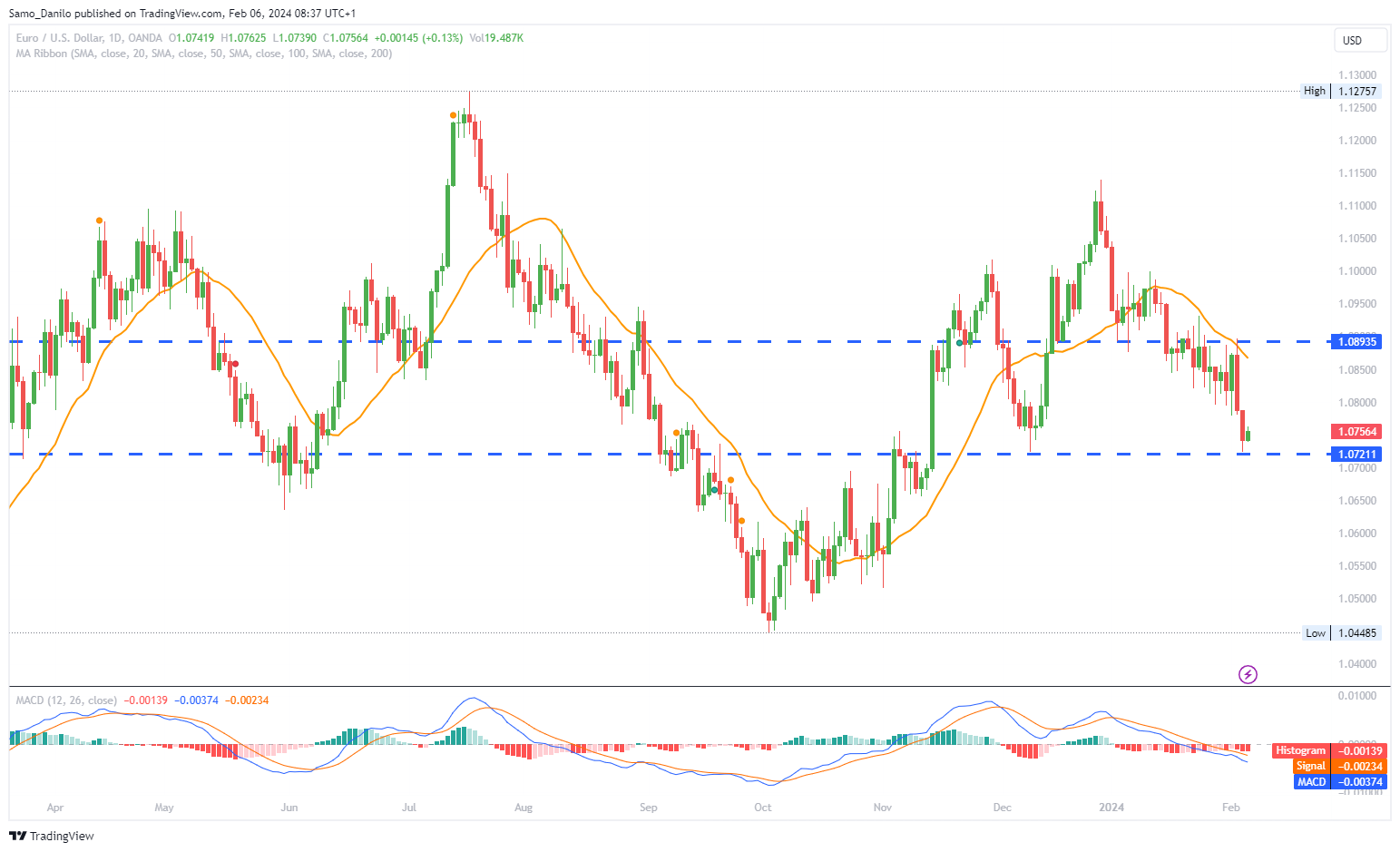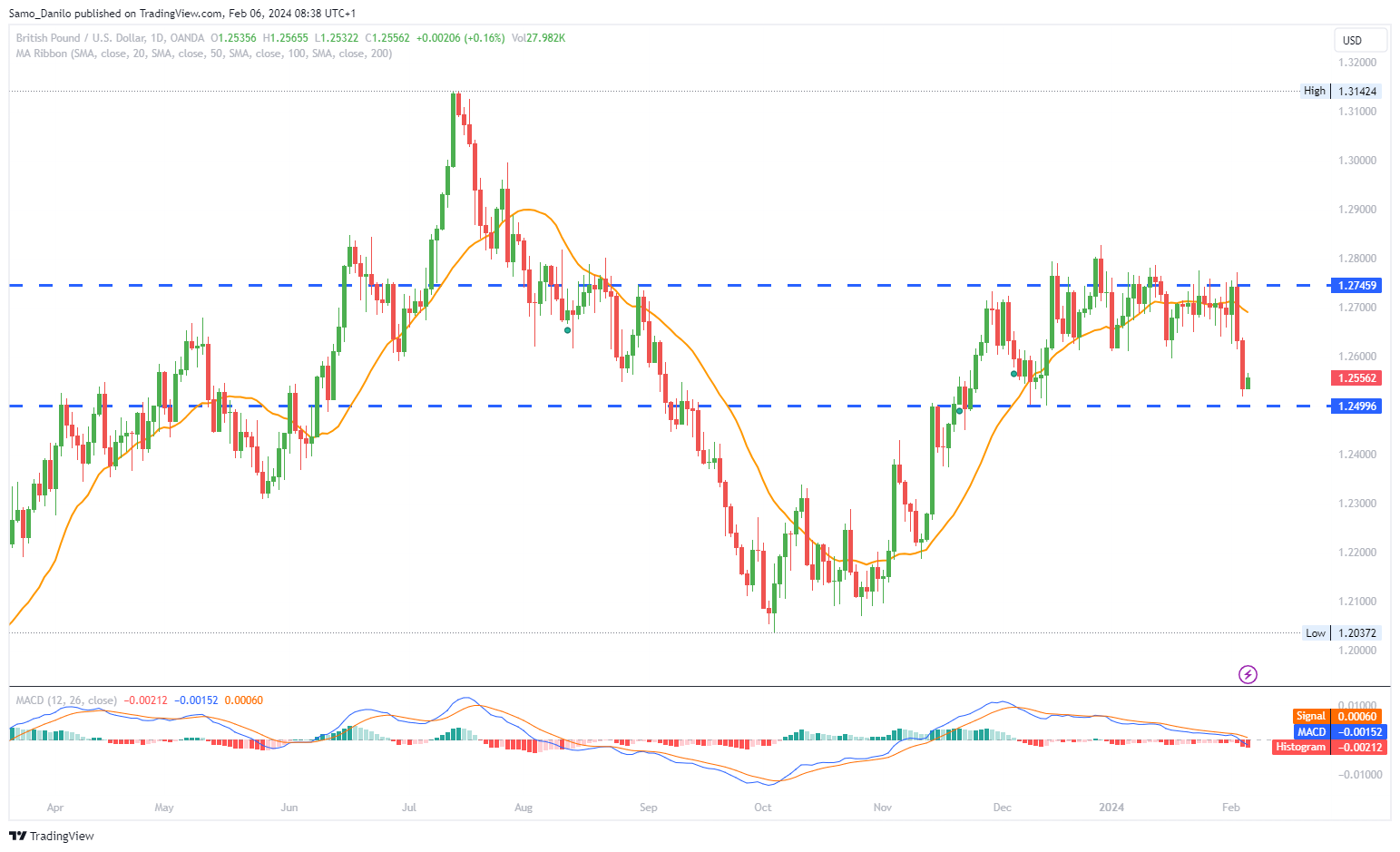EURUSD
- The EUR/USD has experienced a significant move in two consecutive sessions, breaking below the key 200-day Simple Moving Average (SMA) at 1.0836 and the provisional 100-day SMA at 1.0783. The pair reached levels around 1.0720, which were last seen in early December.
- The US Dollar Index (DXY) has seen a strong reinvigoration of its upside bias. This is attributed to investors assessing robust monthly job creation, with Nonfarm Payrolls (+353K) reported on Friday. Additionally, hawkish remarks from Federal Reserve Chief Powell, particularly from an interview on CBS released over the weekend, contributed to the strengthening of the US dollar.
- Powell emphasized that the Federal Reserve should wait for data confirmation that inflation is moving down to 2% in a sustainable way. He also highlighted the current strength of the economy, reducing the risk of a recession.
- The annual EU Producer Price Index (PPI) recorded a substantial decline of 10.6% in December. This exceeded the expected decrease of 10.5% and surpassed the previous figure of 8.8%. The PPI is an indicator of the average changes in prices received by domestic producers for their output.
- According to the Organization for Economic Co-operation and Development (OECD), inflation in Europe is anticipated to persist above the European Central Bank's (ECB) 2% target until some point after 2025. This outlook suggests a prolonged period of inflation above the central bank's target.
Closing statement: the information highlights the technical movement of EUR/USD below key SMAs, the strengthening of the US dollar based on robust economic indicators and Powell's remarks, a decline in the EU PPI, and the OECD's outlook on inflation in Europe. These factors collectively contribute to the dynamics of the EUR/USD currency pair.
GBPUSD
- GBP/USD is undergoing recovery gains during the European morning on Tuesday. The pair is showing signs of rebounding or strengthening.
- The Institute for Supply Management (ISM) reported on Monday that the US ISM Services Purchasing Managers' Index (PMI) climbed to 53.4 in January from 50.5 in December. This suggests an expansion in the services sector, indicating positive economic growth.
- The Services PMI data, coupled with labor market data, implies that the economic growth momentum from the fourth quarter has carried over into the new year. This development reduces the likelihood of an interest rate cut by the Federal Reserve in March.
- The UK S&P Global/CIPS Composite PMI increased to a reading of 52.9 in January. This exceeded market expectations, which anticipated the index to remain the same at 52.5. The higher reading suggests positive economic activity in the UK.
- The Chief Economist of the Bank of England (BoE), Huw Pill, stated on Monday that interest rates could drop this year as a reward to the economy for bringing inflation down. This suggests a potential shift in the monetary policy of the Bank of England.
| SMA (20) | Neutral | |
| RSI (14) | Slightly Falling |
|
| MACD (12, 26, 9) | Slightly Falling |
|
Closing statement: GBP/USD is experiencing recovery gains, and economic indicators such as the US ISM Services PMI and UK S&P Global/CIPS Composite PMI are influencing market sentiment. The data indicates positive economic growth momentum, reducing the likelihood of a US interest rate cut in March. Additionally, the BoE Chief Economist's statement implies the possibility of interest rate adjustments in the UK.
GOLD
- Gold price is experiencing subdued range-bound price action during the early European session on Tuesday. This suggests that the price movement is limited and does not show significant fluctuations.
- Gold is consolidating its losses recorded over the past two days, bringing the price to the $2,015 area. This indicates a period of stabilization after a decline and a potential base forming at the current price level.
- Early on Monday, gold received some support from escalating geopolitical tensions in the Middle East. Geopolitical events often influence gold prices, as it is considered a safe-haven asset during times of uncertainty.
- The sentiment around gold shifted later in the day on Monday as the US ISM Services Purchasing Managers' Index (PMI) came in stronger at 53.4 in January. The stronger-than-expected data, with increased new orders and rebounding employment, influenced market sentiment.
- Gold price succumbed to fading hopes of early and steep interest rate cuts by the Federal Reserve. Markets are now pricing in 115 basis points (bps) of cuts this year, compared with around 150 bps of reductions anticipated a month ago, according to CME Group’s FedWatch tool.
- Minneapolis Fed President Neel Kashkari argued on Monday that a possibly higher neutral rate means that the Fed can take more time before deciding whether to cut. This suggests a cautious approach by the Fed regarding interest rate decisions.
| SMA (20) | Slightly Falling |
|
| RSI (14) | Slightly Falling |
|
| MACD (12, 26, 9) | Neutral |
Closing statement: gold is currently experiencing subdued and consolidated price action, influenced by factors such as geopolitical tensions, economic data like the US ISM Services PMI, and shifting expectations regarding Fed interest rate cuts. The market sentiment is evolving based on these factors.
CRUDE OIL
- Western Texas Intermediate (WTI) is trading around $72.90 on Tuesday. WTI prices are experiencing a modest increase, partially attributed to the slight decline of the US Dollar.
- US Crude Oil prices are extending last week's rejection slide from the 100-day Simple Moving Average (SMA), situated around the $79.20 area. This SMA acted as a resistance level, and prices have been drifting lower for the fourth successive day.
- Geopolitical tensions in the Middle East are noted as a factor that might limit the downside of oil prices. Geopolitical events, especially those affecting oil-producing regions, can influence oil prices due to concerns about supply disruptions.
- The stronger-than-expected US Purchasing Managers' Index (PMI) and Nonfarm Payrolls (NFP) data are mentioned as potential influencers. If the data convinces the Federal Reserve (Fed) to keep its benchmark rate higher for longer, this could lead to a stronger US Dollar. A stronger dollar typically exerts selling pressure on commodity prices, including oil.
- The inability of the commodity to attract meaningful buying is noted. This lack of buying interest suggests that the path of least resistance for WTI prices remains to the downside, indicating bearish sentiment in the market.
| SMA (20) | Slightly Rising |
|
| RSI (14) | Slightly Falling |
|
| MACD (12, 26, 9) | Slightly Falling |
|
Closing statement: the current trend for WTI prices is modestly higher, influenced by factors such as the US Dollar movement, geopolitical tensions in the Middle East, and the potential impact of US economic data on Fed policy decisions. However, the overall sentiment appears bearish, with a noted lack of significant buying interest.
DAX
- the current trend for WTI prices is modestly higher, influenced by factors such as the US Dollar movement, geopolitical tensions in the Middle East, and the potential impact of US economic data on Fed policy decisions. However, the overall sentiment appears bearish, with a noted lack of significant buying interest.
- Despite the challenges in trade data, better-than-expected service sector Purchasing Managers' Index (PMI) numbers provided mid-session support. The German Services PMI declined from 49.3 to 47.7 in January, which was better than the preliminary estimate of 47.6.
- Germany’s Factory Orders unexpectedly rebounded strongly in December, according to official data published by the Federal Statistics Office. On a monthly basis, contracts for goods ‘Made in Germany’ jumped 8.9%, indicating a significant improvement and surpassing forecasts.
- Later in the session, Eurozone retail sales data is mentioned as needing consideration. A larger-than-expected decline in retail sales could fuel fears of a Eurozone recession.
- Investors are advised to track corporate earnings. Specifically, Infineon Technologies is highlighted as one of the big names set to release earnings on Tuesday.
| SMA (20) | Slightly Rising |
|
| RSI (14) | Slightly Falling |
|
| MACD (12, 26, 9) | Slightly Rising |
|
Closing statement: In summary, the DAX is navigating challenges related to weakening demand, as indicated by trade data, but finding support from better-than-expected service sector PMI numbers and a rebound in German factory orders. The upcoming Eurozone retail sales data and corporate earnings, especially from key companies like Infineon Technologies, are identified as factors that investors should closely monitor.




